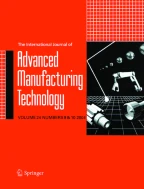Abstract
The present study aims at solving weld quality monitoring problem in small scale resistance spot welding of titanium alloy. Typical dynamic resistance curves were divided into several stages based on the weld nugget formation process. A smaller electrode force or lower welding current was found to promote the initial resistance peak. The bulk material heating stage could not be detected under very high welding current condition. Electrode force effect on dynamic resistance and failure load was much smaller than that of welding current. Principal component analysis was made on discrete dynamic resistance values. The first principal component was selected as independent variable in regression analysis for quality estimation. A back propagation neural network model was then proposed to simultaneously predict the nugget size and failure load. The electrode force, welding current, welding time, and first five principal components were designed as network inputs. Effectiveness of the developed model was validated through data training, testing, and validation. The realtime and online quality monitoring purpose could be realized.
Similar content being viewed by others
References
Wan X, Wang Y, Zhao D (2015) Multi-response optimization in small scale resistance spot welding of titanium alloy by principal component analysis and genetic algorithm. Int J Adv Manuf Technol. doi:10.1007/s00170-015-7545-9
Dickinson D, Franklin J, Stanya A (1980) Characterization of spot welding behavior by dynamic electrical parameter monitoring. Weld J 59(6):170–176
Cho Y, Rhee S (2002) Primary circuit dynamic resistance monitoring and its application to quality estimation during resistance spot welding. Weld J 81(6):104–111
Zhou K, Cai L (2013) Online nugget diameter control system for resistance spot welding. Int J Adv Manuf Technol 68(9-12):2571–2588. doi:10.1007/s00170-013-4886-0
El-Banna M, Filev D, Tseng F (2011) Force-based weld quality monitoring algorithm. Int J Intell Syst Technol Appl 10(1):1–14
Podržaj P, Simončič S (2013) Welding force as a variable in resistance spot welding control. In: 2nd International Conference on Measurement, Information and Control (ICMIC), Harbin, China, 16-18 Aug, pp 818–821
Podržaj P, Simončič S (2012) Image-based electrode tip displacement in resistance spot welding. Meas Sci Technol 23:1–7. doi:10.1088/0957-0233/23/6/065401
Podržaj P, Simončič S (2014) Resistance spot weld strength estimation based on electrode tip displacement/velocity curve obtained by image processing. Sci Technol Weld Join 19(6):468–475. doi:10.1179/1362171814Y.0000000212
Podržaj P, Simončič S (2014) A machine vision-based electrode displacement measurement. Weld World 58(1):93–99. doi:10.1007/s40194-013-0086-7
Zhang H, Hou Y, Zhang J, Qi X, Wang F (2015) A new method for nondestructive quality evaluation of the resistance spot welding based on the radar chart method and the decision tree classifier. Int J Adv Manuf Technol 78(5-8):841–851. doi:10.1007/s00170-014-6654-1
Podržaj P, Simončič S (2013) Resistance spot welding control based on the temperature measurement. Sci Technol Weld Join 18(7):551–557. doi:10.1179/1362171813Y.0000000131
Podržaj P, Polajnar I, Diaci J, Kariž Z (2005) Estimating the strength of resistance spot welds based on sonic emission. Sci Technol Weld Join 5(4):699–405. doi:10.1179/174329305X44107
Podržaj P, Polajnar I, Diaci J, Kariž Z (2004) Expulsion detection system for resistance spot welding based on a neural network. Meas Sci Technol 15:592–598. doi:10.1088/0957-0233/15/3/011
Cullen J, Athi N, Al-Jader M, Johnson P, Al-Shamma’a A, Shaw A, El-rasheed A (2008) Multisensor fusion for on line monitoring of the quality of spot welding in automotive industry. Mesaurement 41(4):412–423. doi:10.1016/j.measurement.2007.01.006
Podržaj P, Simončič S (2011) Resistance spot welding control based on fuzzy logic. Int J Adv Manuf Technol 52:959–967. doi:10.1007/s00170-010-2794-0
Lee H, Wang M, Maev R, Maeva E (2003) A study on using scanning acoustic microscopy and neural network techniques to evaluate the quality of resistance spot welding. Int J Adv Manuf Technol 22(9-10):727–732. doi:10.1007/s00170-003-1599-9
El-Banna M, Filev D, Chinnam R (2008) Online qualitative nugget classification by using a linear vector quantization neural network for resistance spot welding. Int J Adv Manuf Technol 36(3-4):237–248. doi:10.1007/s00170-006-0835-5
Lai X, Luo A, Zhang Y, Chen G (2009) Optimal design of electrode cooling system for resistance spot welding with the response surface method. Int J Adv Manuf Technol 41(3-4):226–233. doi:10.1007/s00170-008-1478-5
Ruisz J, Biber J, Loipetsberger M (2007) Quality evaluation in resistance spot welding by analysing the weld fingerprint on metal bands by computer vision. Int J Adv Manuf Technol 33(9-10):952–960. doi:10.1007/s00170-006-0522-6
Chen J, Farson D, Ely K, Frech T (2006) Modeling small-scale resistance spot welding machine dynamics for process control. Int J Adv Manuf Technol 27(7-8):672–676. doi:10.1007/s00170-004-2238-9
Tseng K, Chuang K (2012) Monitoring nugget size of micro resistance spot welding (micro RSW) using electrode displacement-time curve. Adv Mater Res 463-464:107–111. doi:10.4028/www.scientific.net/AMR.463-464.107
Chen Y, Tseng K, Cheng Y (2012) Electrode displacement and dynamic resistance during small-scale resistance spot welding. Adv Sci Lett 11(1):72–79. doi:10.1166/asl.2012.2180
Tan W, Zhou Y, Kerr H, Lawson S (2004) A study of dynamic resistance during small scale resistance spot welding of thin Ni sheets. J Phys D-Appl Phys 37(14):1998–2008. doi:10.1088/0022-3727/37/14/017
Wan X, Wang Y, Zhao D (2015) Quality evaluation in small scale resistance spot welding by electrode voltage recognition. Sci Technol Weld Join. doi:10.1080/13621718.2015.1115161
Kahraman N (2007) The influence of welding parameters on the joint strength of resistance spot-welded titanium sheets. Mater Des 28(2):420–427. doi:10.1016/j.matdes.2005.09.010
Kaya Y, Kahraman N (2012) The effects of electrode force, welding current and welding time on the resistance spot weldability of pure titanium. Int J Adv Manuf Technol 60(1-4):127–134. doi:10.1007/s00170-011-3604-z
Pearson K (1901) On lines and planes of closest fit to systems of points in space. Philos Mag Series 2(11):559–572
Hotelling H (1933) Analysis of a complex of statistical variables into principal components. J Educ Psychol 24(6):417–441
Author information
Authors and Affiliations
Corresponding author
Rights and permissions
About this article
Cite this article
Wan, X., Wang, Y. & Zhao, D. Quality monitoring based on dynamic resistance and principal component analysis in small scale resistance spot welding process. Int J Adv Manuf Technol 86, 3443–3451 (2016). https://doi.org/10.1007/s00170-016-8374-1
Received:
Accepted:
Published:
Issue Date:
DOI: https://doi.org/10.1007/s00170-016-8374-1
